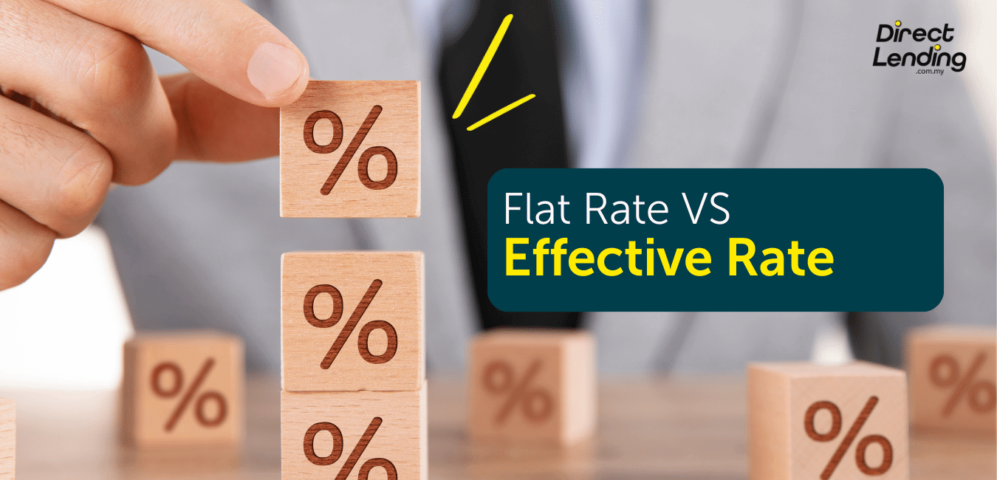By Yik Seong
Director
What is flat rate vs. effective interest rate & fixed rate vs. floating rate?

When talking about interest rate and repayment for loans, you might come across various terminologies such as flat rates, effective rates, fixed rates, and floating rates. What are the differences and functions of these different rates?
This article aims to provide an explanation of these different rates and their functions in determining the interest amount a borrower will have to pay for his/ her loan.
Flat Rate vs. Effective Rate

Both flat rate and effective rate are methods used by lenders in calculating the interest and installment for financing.
What is Flat Rate?
Flat rate is commonly used for personal loans and hire purchase financing (such as car or motorcycle loans) and is an accessible approach to measure interest. With flat rate, interest payments are calculated based on the original loan principal.
Formula
Monthly payment = [(P × r × t) + P] / ( t × 12)
Whereby:
P = Principal (amount applied)
r = interest rate (flat rate %)
t = tenure in years
1. Total interest cost at the end of tenure = P × r × t
2. Total loan repayment amount at the end of tenure = P + interest charged
3. Monthly payment = Total loan repayment amount / tenure in months
Let us apply this formula in a situation to see how it works.
Situation A: Mr. Tan wishes to apply for a loan from Bank A for RM 100,000 with 5 years of tenure. Bank A offers Mr. Tan a flat rate of 5%. The calculation for the monthly payment for Mr. Tan’s loan will be as follows:
Monthly payment = [(RM100,000 × 5% × 5) + RM100,000]/ (5 × 12)
1. Total interest cost at the end of tenure = RM100,000× 5% × 5
= RM25,000
2. Total loan repayment amount at the end of tenure = RM100,000+RM25,000
= RM125,000
3. Monthly payment = RM125,000 / 60
= RM2,083
Based on the calculation above, if Mr. Tan gets the loan from Bank A, his monthly installment will be RM2,083 per month for 5 years.
The interest charged for every year during the loan tenure will always be 5% of the original loan amount (i.e RM100,000 in this case) even after he may have paid RM50,000 installment for the loan. Hence, Mr. Tan will end up paying RM25,000 interest costs for the whole 5-year tenure.
What is Effective Rate?
As the name suggests, effective interest rate (EIR) is the true interest rate that you are paying after considering the payment you have made to the loan and the effect of interest compounding to the outstanding loan. This rate is commonly used in mortgage/ housing loans.
Let’s see the following situation to understand the difference between effective rate and flat rate:
Situation B: Mr. Tan applied for a loan at Bank B amounting to RM100,000 with an effective rate of 5% for 5 years
The interest charged for the first year will be RM100,000 x 5% = RM5,000, the same as situation A. However, in the second year, the interest charged will be 5% on the outstanding loan amount at the start of year 2.
For simplicity and illustration purposes, assuming Mr. Tan pays RM20,000 in year 1, the outstanding loan amount at the start of year 2 will be:
Original loan amount = RM100,000
(+) Interest charged for year 1 = RM5,000
(-) Repayment by Mr. Tan in year 1 = RM20,000
Outstanding balance at the end of year 1 = RM85,000
In this case, Mr. Tan’s interest cost for year 2 will only be RM4,250 (RM85,000 x 5%) compared to RM5,000 for flat rate interest.
The true cost of loans
Using Mr. Tan’s situation, you can see that the actual interest cost is different by using either a flat or effective rate. Lenders should provide you with both flat and effective loan offerings, so you are able to compare between the two. In order to know the real cost, you would need to know and calculate the effective interest rate of the loan. Make sure you compare 2 loan products like for like by looking at the effective rate.
What if a borrower wants to settle a loan early?

A common question by borrowers who take personal loans or car loans is whether they will need to pay the full interest cost for their loan if they decide to settle early. In the case of Mr. Tan for situation A, does he have to pay the full RM25,000 interest cost if he settles the loan early?
In general, a lender will provide a rebate if a borrower decides to settle their loans early. Do check the terms and conditions of your loan agreement. While the actual amount of rebate is provided by the lender is on a discretionary basis, in principle, the lender will use the effective interest rate calculation method to determine the rebate.
The concept of rebate is less relevant for loan calculating using effective rate as the loan principle outstanding balance is available for interest calculation, hence is more straightforward when a borrower wants to early settle the loan.
Situation C: Mr. Tan borrowed RM100,000 with a flat rate of 5% for 5 years. Let’s say he decides to settle his loan after year 2
1) Settle loan using flat rate
Loan amount paid = Monthly payment ×12 × number of years paid
= RM2,083 ×12 × 2 years
= RM49,992
The calculation above shows the total amount that Mr. Tan has paid for the first 2 years.
What is the remaining loan balance left for Mr. Tan to settle? The calculation below shows the remaining balance he should pay based on the flat rate calculation.
Loan balance = Total loan amount – loan amount paid
= RM125,000-RM49,992
= RM75,008
Based on the flat rate calculation, after 2 years Mr. Tan would have to pay RM75,008 to fully settle his loan.
2) Settle using effective rate
| Year | Beginning balance | Interest (Beginning balance x effective interest of 7.93%) | Payment per year (Monthly payment x 12) | Ending Balance |
| 1 | 100,000 | 7,931 | (25,000) | 82,931 |
| 2 | 82,931 | 6,577 | (25,000) | 64,508 |
| 3 | 64,508 | 5,116 | (25,000) | 44,624 |
| 4 | 44,624 | 3,539 | (25,000) | 23,163 |
| 5 | 23,163 | 1,837 | (25,000) | 0 |
Using the calculator referred above, the effective interest rate of this loan is 7.93%. Based on the effective rate calculation after paying for 2 years, Mr. Tan would need to pay RM44,624 to fully settle his loan.
When Mr. Tan decided to settle his loan in year 3 rather than the original 5- year tenure of the agreement, he should not be paying the “extra interest” for the remaining 2 years. Hence, the bank will use the effective interest to calculate the “effective” outstanding loan balance, which in this example is RM44,624.
In practice, lenders will have some charges imposed for early settlement, hence, the actual early settlement amount will be RM44,624 plus charges. The difference between RM75,008 and the early settlement amount is the “rebate” provided by the lender.
Fixed rate vs. Floating rate
Both fixed rates and floating rates are used to determine the interest rate for loan products – from mortgages, car loans to personal financing.
What is a fixed rate?

A fixed rate is an interest rate that is the same throughout the tenure of the loan’s lifetime.
Advantages of Fixed Rate
1) Interest cost is certain
As the interest rate is fixed or the same throughout the loan’s agreement, the element of uncertainty is removed as the interest payment is known. The interest payment is to stay the same throughout the agreement. Thus, there is no uncertainty or unexpected risks associated with the loan.
2) Monthly installment does not change
Since the fixed rate does not change, monthly payments will also remain constant throughout the loan’s life. Hence, the borrower can efficiently allocate the exact amount of payment every month.
Disadvantages of Fixed Rate
1) Higher interest
Compared to other interest rates, fixed interest is generally higher in terms of products in the market. To compensate against potential risks, the fixed interest is usually a bit higher to accommodate unwanted interest rate fluctuations in the market. The lender typically imposes this to ensure that they are receiving enough interest to cover any potential risk.
2) Rate does not fluctuate according to the market
As stated above, the fixed interest is typically higher when associated with a product. This means that the rate is fixed at the same amount despite market interest fluctuating. This serves as a disadvantage when market interest has fallen and is deemed lower, but the borrower needs to pay the same amount as the higher fixed interest.
What is a floating rate?

A floating rate is broadly known as a variable interest rate since it can fluctuate over the loan tenure. In other ways, floating rates occasionally vary with the overall market, with an underlying index. Nonetheless, when the interest rate rises, borrowers with floating rate loans will discover the monthly installment on their loan will increase and vice versa.
FLOATING RATE = REFERENCE RARE + SPREAD
The floating rate consists of a reference rate such as Base Rate (BR) and Base Lending Rate (BLR) and spread or effective bank rate. The reference rate influences the overall repayment amount of your loan during the repayment period of the loan.
To know more about the different reference rates and the latest Revised Reference Rate Framework, you can read this article.
The effective bank rate is also known as the interest rate margin or loan spread. The effective bank rate is generally affected by borrowing credit risk, liquidity risk premium and operating cost, and the bank’s profit margin. The effective bank rate covers the potential cost of a lending loan and the risks associated with it.
Advantages of Floating Rate
1) Lower interest rate
The floating interest rate is lower than the fixed interest rate, subsequently reducing the borrower’s absolute amount of financing. Regardless of whether the rate has increased, it would not be for the entire period. Interest rates are periodical as time goes on and will drop sometime over the loan tenure.
2) Yields benefit to both borrowers and banks
There is continuously an opportunity for unforeseen situations. The borrower will derive benefit if interest rates fall off because the floating rate will slope downwards. The bank will be fond of extra earnings if interest rate upturns since they can uplift the floating rate owed to the borrower.
Disadvantages of Floating Rate
1) Interest rate determined by market conditions
The interest rate generally relies upon market circumstances which can end up being dynamic and wavering. The interest rate may increase to the point that the advance may get hard to offset. Borrowers might have to pay more than the initial interest when market interest increases.
2) Distressful in budgeting
The volatility of interest rate changes makes budgeting more burdensome for the borrower. It likewise makes it harder for the bank to project future net worth precisely. Borrowers who prefer to have stability and predictability in budgeting might have a hard time budgeting their monthly loan repayment as the amount of repayment varies from time to time.
3) Charging unnecessary charges
Amid threatening economic situations, financial institutions attempt to avoid any risks by putting the weight on clients. They will charge high premiums over the benchmark rate, eventually affecting the finances of borrowers. Ultimately, on account of the fluctuating idea of floating interest rates, the monthly repayments will shift all through the whole loan period.
Fixed Rate and Floating Rate in Loans
| Fixed Rate | Floating Rate | |
| Monthly Installment | Constant throughout the loan’s lifetime, calculated based on the initial lump sum | Varies throughout the loan’s lifetime, calculated based on current floating rate |
| Interest behavior | Constant, does not change | Changes based on the market |
| Cost of interest | Higher interest, taking account of operating costs of the loan, unwanted market risks, and profitability in the long run | Lower interest, interest can change based on the current risks and fewer risks associated with the loan |
| Type of borrower | Risk averse, suitable for those who want stability and predictability | Risk taker, those who prefer to benefit from market changes |
Based on the table above, you can identify the differences between each rate and this makes it easier for you to compare between the two when deciding to apply for a loan.
What should you do as a borrower?

Now that you know the differences between fixed rate and floating rate, it will be easier for you to understand your loan better. As a borrower, it is important for you to be aware of the type of interest the loan you want to apply offers – whether it is a fixed rate loan or a floating rate loan.
Consider taking fixed rate loans if you want convenience and stability during the loan repayment period.
Apply for floating rate loans if you have a bigger income to accommodate to the increase of monthly installments during the loan repayment period. That being said, floating rate loans will also benefit if the market interest decreases, and borrowers can benefit from the lower interest rate.
Each option differs for each borrower, so selecting a fixed rate loan or a floating rate loan depends on the borrower’s needs, the ability for repayment, and overall financial profile.
Before applying for a loan, make sure you do proper research and make informed decisions that will suit you as a borrower. There are various things to consider before applying for a loan, you can read more about it here.
This article is prepared by Direct Lending, an online lending platform that helps you to find, make comparisons, and apply for safe, affordable, and suitable financing for your needs.
Might be wondering which loan best suits you? Fret not, our experienced and friendly loan consultants will be ready to help you find the best loan for your financing needs.
Our service is 100% free, with no upfront payments or processing charges.
About the writer
Yik Seong
Yik Seong is the founder of Direct Lending and Chartered Financial Analyst (CFA) Charterholder, with over 20 years of finance experience working in Malaysia, London, Singapore, and Hong Kong. Driven by his passion for finance, Yik Seong founded Direct Lending with a mission to provide safe and affordable financing to individuals with restricted access to credit channels. He enjoys long hikes during the weekend and never skips a morning coffee.



